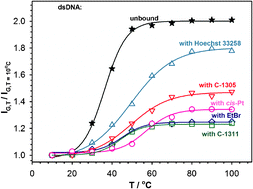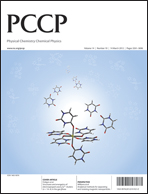Several medicinally important compounds that bind to dsDNA strands via intercalation (C-1311, C-1305, EtBr), major groove binding (Hoechst 33258) and covalent binding (cis-Pt) were examined. The obtained results suggest that both the transfer of conformation B to C and the denaturation process, for the ligand–dsDNA complexes, except for covalently bound cis-Pt, took place at higher temperatures compared to the unbound helix. Furthermore, much lower currents of electrooxidation of guanine at 100 °C, compared to the currents obtained at this temperature for dsDNA in the absence of ligands, suggest that the binding of ligands affects the way the dsDNA denaturates at increased temperatures and leads to formation of different forms of DNA single strands. The voltammetric results were compared with the data of two spectroscopic techniques: UV-Vis and CD.
You have access to this article
 Please wait while we load your content...
Something went wrong. Try again?
Please wait while we load your content...
Something went wrong. Try again?


 Please wait while we load your content...
Please wait while we load your content...